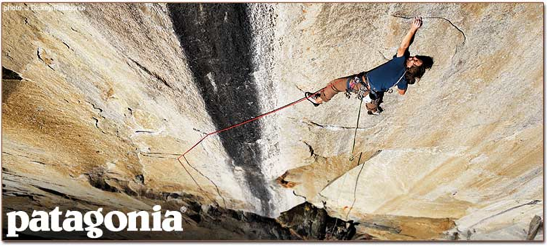Dear REI,
Your products are good, but you are missing a bit of edge. With you, I’m getting a durable jacket. With Patagonia, I’m getting a durable jacket and helping to save the planet. That’s how Patagonia makes me feel about their products. Pretty powerful, right?
The thing is, you are doing good work too. I just read your stewardship report. Like Patagonia, you give of money away, involve your employees in the process, promote conservation and outdoor activity, and buy carbon-emissions offsets. In fact, I was surprised about many of the programs that you have which go unnoticed.
Here are 3 things you should be doing:
1. Put a face on it.
Patagonia is Yvon Chouinard, a radical, rough-handed adventurer who believes quality is king and that the planet isn’t ours to piss on. Although consumer Jane probably doesn’t know about Yvon, she still knows that Patagonia products are made, managed and sold by outdoor fanatics and conservationists who run ragged in the clothes they sell. This is the way Patagonia has shaped it. They’ve made their company stand for the planet in addition to quality. Like Nike, Patagonia gives customers something to aspire to (athleticism, adventure, freedom).
Your website. It’s more of a sales rack, than an experience. It’s full of products instead of rocks, rivers, mountains and ideas.
2. Stand for something.
Where’s your stand? What’s your mission? Accessible mid-range outdoors products? That’s not enough. It seems your mission isn’t strong enough to guide your decisions, so any good intentions are thwarted by focus on the immediate bottom-line. Zappos.com is number one in customer service. It costs more to offer consumers free return shipping and to surprise them with overnight delivery at the time of each decision, but the mission guides these micro-decisions and builds a more successful company.
Try this out: You’re a consumer cooperative and that’s pretty cool. That means you already have a unique and interesting way to engage, please and communicate with customers. Build on it!
- There’s a lot of grumpiness about your dividend policy (the 10% back a member receives from what they buy every year). Give people three easy ways to redeem their dividends.
- Open up your retail stores for members to hold events or workshops.
- Organize member-only events.
- Let customers know that whatever dividends they don’t claim will go to an independent charity (voted on by members) and that you’ll match the amount. Then, tell us the impact of these donated dividends because we really do care.
- Create a clothing and equipment in-store swap for members. This could dip into your sales or bring more people into your stores to buy. Either way, think of the community and loyalty you’ll build. Donate whatever isn’t claimed.
3. Take a risk.
Your commitments to reduced energy, paper and waste, sustainable fibers and energy efficient stores are dumbed down by qualifiers, excuses and apologies like “seek” and “strive” and “prefer.” I give you credit for admitting your failures, but they seemed like half-baked attempts from the start. Any good intentions you have are thwarted by “higher fuel prices…insufficient sources for recycled paper…and environmental initiatives that don’t make financial sense.”
Patagonia didn’t wait until there was an easy answer to convert all of its cotton from industrial to organic. They couldn’t wait because they saw it as an ethical imperative. They hunted for suppliers and, finding too few, worked to support and develop new suppliers; they re-designed products and packaging; subsidized prices at first and braced themselves for lower sales. Yvon talks a lot about the hazards of the industrial cotton industry (by Thomas at dress head). He doesn’t once mention that this environmental initiative “made financial sense.” Patagonia increased the availability of organic cotton for other companies like Nike, The Gap and Levi. Heck, I’m sure you’re also benefitting from the risks Patagonia took in 1996.
Okay, your turn. I’d love to know what you think, especially where you disagree with me.





 I'm Olivia Khalili. I created Cause Capitalism to show you how to grow your business by incorporating a social mission.
I'm Olivia Khalili. I created Cause Capitalism to show you how to grow your business by incorporating a social mission. 

Awesome article Olivia. I love Patagonia as well and find their business model and their mission very inspiring. A few years ago in school, we created a fictional wet suit and all surf-things related company, based on many of the principals of Patagonia. It was very challenging to not sacrifice our vision for larger margins or an easier route. But in the end, it was fulfilling to see the type of company we created. As a consumer, buying from Patagonia or companies like Patagonia make you feel good about buying the product, not because you like the product, but because you like the Earth. Personally, I feel a sense of empowerment when I buy sustainable products from responsible companies, and am happy to give my dollars to them to support their mission.
Thanks Sarah. That’s really fascinating about your project. Do you remember any of the specific dilemmas you struggled with? I don’t pretend that it’s easy. It wasn’t for Patagonia, I know. I find that the stronger a business’ mission is (and this goes for my personal mission as well), the easier will be to make these decisions. They make be short-term sacrifices, but they fulfill a greater purpose. Thanks for your input.
It is a tough business environment for most companies and you need something to separate you from your competitors in the minds of your customers. As you have pointed out incorporating a social mission in your business plan is one way to stand out from the crowd. If it leads to higher profits, all the better! There is nothing better than being rewarded for doing good.
Robert, thanks for your thoughts. And I agree with you that these programs as needing to be tied directly to business objectives to warrant the attention and to reach their full potential to effect change.
Thanks,
Olivia
I stumbled upon your article after getting emails from both REI and Patagonia today and thinking I really should get a new jacket this weekend… But which jacket… And the Google gods sent me to your very smart article. Well done. I’ve been a long-time Patagonia fan, and still wear a jacket I got at their San Francisco store 31 years ago (no lie). I like REI too and now live in a town that has both (plus North Face). But you reminded me what I have always loved about Patagonia. Really great read.
Jill,
I appreciate the comments — thanks. Patagonia and REI are really terrific businesses!